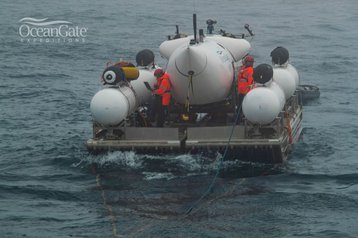The company that owned and operated the submarine lost and presumed destroyed while exploring the Titanic relied on satellite connectivity from Elon Musk’s Starlink service. The use of the service, however, was unrelated to the loss of the vessel.
“Despite being in the middle of the North Atlantic, we have the internet connection we need to make our Titanic dive operations a success - thank you Starlink!” OceanGate Expeditions tweeted earlier this month. “The wreck of the Titanic lies about 400 miles off the coast of Newfoundland. Without any cell towers in the middle of the ocean, we are relying on Starlink to provide the communications we require throughout this year’s 2023 Titanic Expedition.”
In reply at the time, Starlink replied: “Internet from space supporting Titanic dive expedition.”
Five passengers aboard the Titan submersible were killed this week while exploring the Titanic shipwreck, some 12,500 feet below the ocean's surface, around 350 miles off the coast of Newfoundland, Canada. The sub lost contact with the surface around 1 hour and 45 minutes into a 2-and-a-half-hour descent. Wreckage from the vessel was found a few days later, suggesting a ‘catastrophic implosion.”
Fact-checking site Snopes claimed this week that the company and the submarine used Starlink for connectivity, before amending its statement to clarify that the company relied on the Low Earth Orbit (LEO) satellite service, rather than the submersible.
In reply to the original Snopes claim, Musk tweeted: “You can’t even run a good psy op.”
GPS and satellite broadband signals are unable to penetrate deep water and would be unable to assist with communications or navigation. It’s most likely that OceanGate’s surface vessel used Starlink services for its communications to the shore.
To communicate with one another, the Titan sub and surface vessel instead sent text messages which are exchanged via a USBL (ultra-short baseline) acoustic system which relies on transponders and receivers. The same communication system was used for navigation.
While it's possible the submersible might have used Starlink for communications while at the surface, it’s unlikely Starlink terminals are ruggedized to the point one could have survived the pressures of the deep ocean. Images of the sub don't appear to show any satellite terminals.
The company’s website is currently offline and little information about the surface vessel is available on a copy of the site saved to the Waybackmachine.
Founded in 2009, OceanGate offered expeditions to explore the Titanic Shipwreck. The Titan vessel, reportedly able to dive to 4,000m below sea level, was made of carbon fiber and titanium alongside “off-the-shelf components helped to streamline the construction”. The company, which charged $250,000 per person, controlled the sub via a $30 Bluetooth gaming controller from Logitech.
The maritime industry has long been a major customer segment for satellite connectivity providers, and newcomer Starlink has been heavily targeting the sector, signing distribution deals with maritime communications firms Marlink, Elcome International, Tototheo Maritime, and Anuvu.
The company’s terminals have been deployed on tankers, container ships, cruise liners, and yachts owned by the likes of Seabourn, Polembros Shipping, Sun Enterprises, Aqua Expedition, Columbia Shipmanagement, Costamare, Enesel, Royal Caribbean, Norwegian Cruise Line, Carnival Corporation, Windstar Cruises, Hurtigruten, SeaDeam, and American Cruise Line. It’s unclear how long OceanGate had been a Starlink customer.
Researchers at the University of Tokyo have developed a new navigation technology, known as muometric wireless navigation system (MuWNS), that relies on cosmic rays – instead of radio waves like GPS. Tests are still ongoing, but in theory, the system could be used for underwater navigation in the future.
DCD sends its sympathies to the people aboard the Titan, their families, and anyone else affected by the incident.

